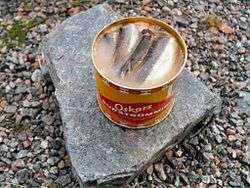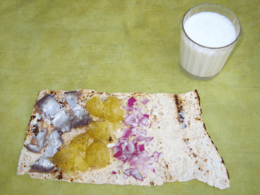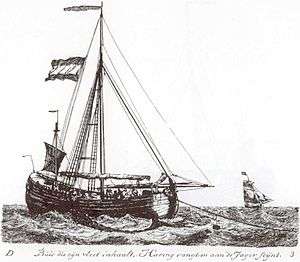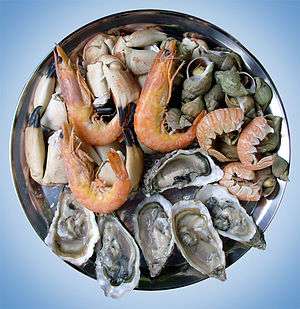Surströmming

Surströmming (pronounced [ˈsʉ̟ːˌʂʈrœmːɪŋ], Swedish for "sour herring") is fermented Baltic Sea herring that has been a staple of traditional northern Swedish cuisine since at least the 16th century.
Just enough salt is used to prevent the raw fish from rotting (chemical decomposition). A fermentation process of at least six months gives the lightly-salted fish its characteristic strong smell and somewhat acidic taste.
When a can of surströmming is opened, the contents release a strong and sometimes overwhelming odour. The dish is ordinarily eaten outdoors. According to a Japanese study, a newly opened can of surströmming has one of the most putrid food smells in the world, even more so than similarly fermented fish dishes such as the Korean Hongeohoe or Japanese Kusaya.[1]
The Baltic herring, known as strömming in Swedish, is smaller than the Atlantic herring, found in the North Sea. Traditionally, the definition of strömming is herring fished in the brackish waters of the Baltic north of the Kalmar Strait.[2] The herring used for surströmming are caught just prior to spawning.
At the end of the 1940s, producers lobbied for a Royal ordinance (Swedish: förordning) that would prevent incompletely fermented fish from being sold. The decree forbade sales of the current year's production in Sweden prior to the third Thursday in August. While the ordinance is no longer on the books, the retailers still maintain the date for the "premiere".[3]
Origin and legends
Fermented fish is an old staple in European cuisines. The oldest archeological findings of fish fermentation are 9200 years old and from the south of today's Sweden.[4] More recent examples are the ancient Greeks and Romans that made a sauce from fermented fish called garum,[5] and Worcestershire sauce also has a fermented fish ingredient.
One explanation for the origins of this method of preservation is that it began long ago when brining food was expensive due to the cost of salt.[6] The fish are marinated in a strong brine solution that draws out the blood, which is replaced by a weaker brine, and the fermentation is done in barrels prior to canning.
During the 17th century, surströmming was supplied as army rations in the Thirty Years' War. Swedish soldiers who did not come from the area where this was staple food, as well as foreign conscripts, refused to eat it.
The canning procedure, introduced in the 19th century, enabled the product to be marketed in shops and stored at home, whereas at one time the final stage would have been storage in large wooden barrels and smaller, one-litre kegs. Canning also enabled the product to be marketed farther south in Sweden to homesick northern Swedes and to southern Swedes as a curiosity and party food, serving as a background to schnapps as other spicy herring preparations do.
Historically, other fatty fish such as salmon and whitefish have been fermented in a way not unlike surströmming; the original gravlax resembled surströmming, whereas nowadays gravlax is made by covering the fish with a salt and sugar mixture that permeates the fish so that it is pickled without the type of fermentation used for surströmming occurring.
Chemical process
The fermentation starts from a lactic acid enzyme in the spine of the fish, and so the fermentation is by autolysis; together with bacteria, pungent smelling acids are formed in the fish such as propionic acid, butyric acid and acetic acid. Hydrogen sulfide is also produced. The salt raises the osmotic pressure of the brine above the zone where bacteria responsible for rotting (decomposition of proteins) can thrive and prevents decomposition of fish proteins into oligopeptides and amino acids. Instead the osmotic conditions enable Haloanaerobium bacteria to prosper and decompose the fish glycogen into organic acids, making it sour (acidic).
Production
The herring are caught in April and May, when they are in prime condition and just about to spawn. Prior to spawning, the herring have not fattened. They are then put into a strong brine for about 20 hours which draws out the blood, the heads are removed and they are gutted and put into a weaker brine solution. The barrels are then placed in a temperature controlled room kept at 15 – 20 °C. Canning takes place at the beginning of July and for five weeks thereafter. Ten days prior to the premiere the final product is distributed to wholesalers. The fermentation of the fish depends on a lactic acid enzyme in the spine that is activated if the conditions are right (temperature and brine concentration). The low temperatures in Northern Sweden is one of the parameters that affects the character of the final product.
Fermentation continues in the can which causes the can to bulge noticeably. Prior to modern canning methods, surströmming was sold in wooden barrels, and was only consumed locally. As even the smallest one litre kegs could leak, surströmming was bought directly from the producers in small quantities for immediate consumption.[7]
Half a year to a year later gases have built up sufficiently for the once flat tops of the cylindrical tins to bulge into a more rounded shape. These unusual containers of surströmming can be found today in supermarkets all over Sweden. However, certain airlines have banned the tins on their flights, considering the pressurised containers to be potentially dangerous (see also below).[8] Species of Haloanaerobium bacteria are responsible for the in-can ripening. These bacteria produce carbon dioxide and a number of compounds that account for the unique odour: pungent (propionic acid), rotten-egg (hydrogen sulfide), rancid-butter (butyric acid), and vinegary (acetic acid).[9]
Eating surströmming

Surströmming is often eaten with a kind of bread known as tunnbröd ("thin bread"). This thin, either soft or crispy bread (not to be confused with crispbread) comes in big square sheets when soft or as rounds of almost a metre in diameter when crisp.[10]
The custom in The High Coast (Höga Kusten), the area of northern Sweden where this tradition originates, is to make a sandwich, commonly known as a "surströmmingsklämma", using two pieces of the hard and crispy kind of tunnbröd with butter, boiled and sliced or mashed potatoes (often mandelpotatis or almond potatoes) topped with fillets of the fish together with finely diced onions. It is also eaten on the plate with the above ingredients. To balance the strong flavour of the fish, Västerbotten cheese is sometimes eaten with it.[11]
In the southern part of Sweden, it is customary to use a variety of condiments such as diced onion, gräddfil (fat fermented milk/sour cream similar to smetana) or crème fraîche, chives and sometimes even tomato and chopped dill.[12]
The surströmming sandwich is usually served with snaps and light beers like pilsner or lager. Other drinks of choice are svagdricka, (lit. "weak drink", a Swedish low alcoholic dark malt beverage brewed since the Middle Ages, a small beer slightly similar to porter),[13] water or cold milk. However, exactly what to drink or not to drink to surströmming is highly disputed among connoisseurs. Some claim that cold milk is the right and only choice while others refer to svagdricka as the most traditional drink. Surströmming is usually served as the focus of a traditional festivity, a "surströmmingsskiva" (surströmming party).
Many people do not care for surströmming, and it is generally considered to be an acquired taste.[14] It is a food which is subject to strong passions, as is lutefisk.
Museum
On June 4, 2005, the first surströmming museum in the world was opened in Skeppsmalen,[15] 30 km (19 mi) north of Örnsköldsvik, a town at the northern end of the High Coast.[16] The name of the museum is "Fiskevistet" (translated to The Fish Visit).
Controversy
German food critic and author Wolfgang Fassbender wrote that "the biggest challenge when eating surströmming is to vomit only after the first bite, as opposed to before".[17]
Food administration rules
Surströmming today contains higher levels of dioxins and PCBs than the permitted levels for fish in the EU; Sweden was granted exceptions to these rules from 2002 to 2011, and a renewal of the exceptions was then applied for. Producers have said that if the application is denied they will only be allowed to use herring less than 17 centimeters long, which contain lower levels, which will affect the availability of herring.[18]
Airline bans
In April 2006, several major airlines (such as Air France and British Airways) banned the fish, claiming that the pressurised cans of fish are potentially explosive. The sale of the fish was subsequently discontinued in Stockholm's international airport. Those who produce the fish have called the airlines' decision "culturally illiterate", claiming that it is a "myth that the tinned fish can explode".[14]
German eviction
In 1981, a German landlord evicted a tenant without notice after the tenant spread surströmming brine in the apartment building's stairwell. When the landlord was taken to court, the court ruled that the termination was justified when the landlord's party demonstrated their case by opening a can inside the courtroom. The court concluded that it "had convinced itself that the disgusting smell of the fish brine far exceeded the degree that fellow-tenants in the building could be expected to tolerate".[19]
See also
- Devil's dung (also considered to have a highly noxious smell)
- Durian (very pungent smelling fruit from southeast Asia)
- Fesikh, Egyptian fermented fish
- Garum, fermented fish sauce
- Hákarl, Icelandic fermented shark
- Kiviak
- Kusaya
- Shiokara, Japanese seafood fermented in highly salted viscera
- List of delicacies
- Rakfisk
- Pickled herring
Notes
- ↑ Excerpt from "Hakkou ha chikara nari", Takeo Koizumi, NHK Ningen Kouza 2002 ISBN 4-14-084183-4
- ↑ They are about one third the size of North Sea herring (Swedish sill) that is adapted to salt water. UNEP (United Nations Environment Programme)
- ↑ Ingeborg Borgenstierna och Thomas Larsson Festdagar – Från Vår fru till vår fru quoted by Nordiska Museet, Stockholm (Swedish)
- ↑ Signs of early settlement in the Nordic region date back to the cradle of civilization, EurekAlert! 8 Feb 2016
- ↑ "Horrible". QI. Series H. Episode 7. London. 29 October 2010. BBC. BBC One.
- ↑ Kurlansky M. "Chapter 8. A Nordic Dream". Salt: A World History. London: Vintage Books. p. 138. ISBN 978-0-09-928199-3.
- ↑ Ruben Madsen, surströmming producer
- ↑ fishupdate.com: Swedish fermented herring dish considered safety risk on airlines, 28 March 2006.
- ↑ McGee, Harold (2004). On Food and Cooking (Revised Edition). Scribner. ISBN 0-684-80001-2. p 236
- ↑ "Olika sätt att äta surströmming". www.aftonbladet.se. Aftonbladet. Retrieved 24 May 2015.
- ↑ Lyregård, Berit (11 August 2005). "Surströmming ska ätas med finess". www.dn.se. Dagens Nyheter. Retrieved 24 May 2015.
- ↑ Schmidt, Claes; Lund, Sara. "Kulturkrock!". www.allas.se. Allas.
- ↑ Axelsson, Rune B (5 July 1992). "Här lever bryggartraditionen. Svagdricka allmogens dryck vid skörd och fest". www.dn.se. Dagens Nyheter. Retrieved 24 May 2015.
- 1 2 Bevanger, Lars (1 April 2006). "Airlines ban 'foul' Swedish fish". BBC. Retrieved 2007-09-24.
- ↑ Location of Skeppsmalen
- ↑ "Ta en tur med vädret". www.expressen.se. Expressen. 18 July 2005. Retrieved 24 May 2015.
- ↑ Wolfgang Fassbender in Swiss newspaper Neue Zürcher Zeitung, August 2011.
- ↑ "Surströmmingen är räddad". Västerbottens-kuriren. 8 April 2011. Retrieved 2011-09-06.
- ↑ Rechtsanwalt Frank – Georg Pfeifer. Störung des Mietgebrauchs durch Mieter.
References
- Ringblom, Fredrik and Westerlund, Örjan (2009) Surströmming: En handbok. Grenadine. ISBN 978-91-85329-81-6. (Swedish)
External links
| Wikimedia Commons has media related to Surströmming. |
- Surströmming.se (Swedish)
- Fermented Herring – Guide and Film
- How to make surströmming at home
- Jamie Oliver enjoys surströmming YouTube
- Food For Louis at Youtube
- Eating Surstromming at Youtube
- http://www.imdb.com/title/tt5943598/ Trailer Park Boys: Out of the Park Europe, Season 1 Episode 5 Stockholm. Aired October 28, 2016. Series characters attempt to eat a can of surstromming.


